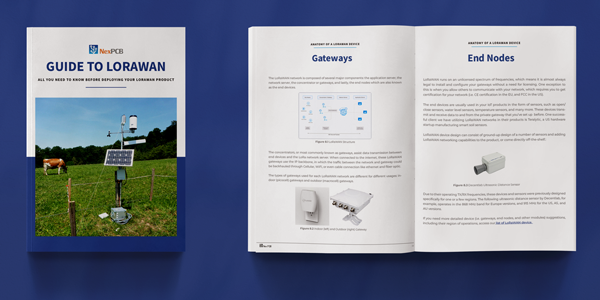Different LoRaWAN Regulations Across the Globe
LoRaWAN is a machine-to-machine communication protocol that has become a go-to standard in the IoT industry. With its scalability potential, we are seeing a wider adoption of LoRaWAN networks in IoT and sensor networks.
But with like all networking technologies, LoRaWAN is subject to regulations at regional and national levels. Therefore, before designing and implementing LoRaWAN end nodes and gateways, you must pay attention to the specifications and configuration of your devices, primarily at what frequency you set your devices to operate.

LoRaWAN is a proprietary networking protocol patented by Semtech Corporation. It is known for its low power, wide-area networking protocol which runs under an unlicensed spectrum. This allows private networks to be established and provides a lower cost (compared to other LPWAN) for setting up. The LoRaWAN alliance offers extensive information on setting up and deploying LoRaWAN networks around the globe.
The LoRaWAN network is composed of several major components: the application server, the network server, the concentrator or gateways, and lastly, the end nodes which are also known as the end devices.
LoRaWAN End Nodes
The end devices are usually used in your IoT products in the form of sensors, such as open/close sensors, water level sensors, temperature sensors, and many more. These devices transmit and receive data to and from the private gateway that you’ve set up before. One successful client we have utilizing LoRaWAN networks in their products is Teralytic, a US hardware startup manufacturing smart soil sensors.
LoRaWAN device design can consist of ground-up design of a number of sensors and adding LoRaWAN networking capabilities to the product, or come directly off-the-shelf just like this LoRaWAN ultrasonic distance sensor by Decentlab:
Due to their operating TX/RX frequencies, these devices and sensors were previously designed specifically for one or a few regions. The following ultrasonic distance sensor by Decentlab, for example, operates in the 868 MHz band for Europe versions, and 915 MHz for the US, AS, and AU versions.
LoRaWAN Gateways
The concentrators, or most commonly known as gateways, assist data transmission between end devices and the LoRa network server. When connected to the internet, these LoRaWAN gateways use the IP backbone, in which the traffic between the network and gateway could be backhauled through Cellular, WiFi, or even cable connection like ethernet and fiber optic.
The types of gateways used for each LoRaWAN network are different for different usages: indoor (picocell) gateways and outdoor (macrocell) gateways.
LoRaWAN runs on an unlicensed spectrum of frequencies, just like WiFi. That means no matter which region you’re deploying these networks in, it is almost always legal to install and configure your gateways without a need for licensing. Just make sure you’re running on an allowed frequency for your region. One exception to this is when you allow others to communicate with your network, which requires you to get certification for your network (i.e. CE certification in the EU, and FCC in the US).
Setting Up LoRaWAN: Devices to Network
- Register on The Things Network (TTN) on https://www.thethingsnetwork.org
- Register your network on https://www.thethingsnetwork.org/docs/gateways/registration/
- Select your appropriate frequency band plan
- Connect your LoRa node to the network, based on the gateway device documentation. For a complete guide on selecting your appropriate devices, check https://www.nexpcb.com/lorawan-selection-guide
- Test to see if your gateway can display transmitted and received data.
One of the most important steps in choosing and setting up your gateway is to select the appropriate frequency band, which ultimately depends on your deployment region. Once you decide on which suitable gateway you are going to use, you can then select the appropriate frequency band plan on TTN.
An example of the devices to be implemented is as follows, the Cisco Wireless Gateway is designed to support the several LoRaWAN standards: EU 863-870 MHz, India 865-867 MHz, US 902-928 MHz, Australia 915-928 MHz, and AS 923 MHz. The frequency bands other than this wouldn’t be supported as easily with the gateway, hence it’s specified for regional use.
Frequency Bands Across Countries
The table below shows the different regions and selected band plans and their respective operation parameters.
|
Europe, Africa, Middle East Region |
US |
China |
Korea |
Japan, MY, SG |
India |
|
|
Frequency bands |
863-870 MHz EU868 |
902-928 MHz US915 |
Data is shown in the table below |
920-923 MHz KR920-923 |
920-923 MHz AS923-1 |
865-867 MHz IN865-867 |
|
Channels |
12 |
64+8+8 |
16 |
16 |
16 |
|
|
Channel BW Up |
125/250 kHz |
125/500 kHz |
125 kHz |
125 kHz |
125 kHz |
|
|
Channel BW Down |
125 kHz |
500 kHz |
125 kHz |
125 kHz |
125 kHz |
|
|
TX Power Up |
+16 dBm |
+20 dBm (allow +30 dBm) |
+14 dBm
|
+16 dBm |
+30 dBm |
|
|
TX Power Down |
+16 dBm |
+27 dBm |
+14 dBm
|
+16 dBm |
+30 dBm |
|
|
Data rate |
250-500k bps |
980-21.9k bps |
250-5.5k bps |
250-50k bps |
250-500k |
The divisions in which each radio frequency band is used are generally described based on the regions divided by the ITU (International Telecommunication Union), in International Radio Regulation -- which divides the world into 3 regions also known as the ITU Regions.
Europe, Africa, Middle East Region
EU868 MHz
The standard is used in any region in which the radio spectrum used is under the ETSI standard. The end devices with this standard should be able to operate in frequencies between 863 MHz to 870 MHz and should feature a data channel structure consisting of at least 12 channels. Within these channels, the first three should correspond to 868.1 MHz, 868.3 MHz, and 868.5 MHz
EU433 MHz
The standard is used in Europe, Africa, the Middle East, the other ITU Region 1 countries, and most countries in Asia (except for China, Japan, and the Taiwan Province).
The end devices with the standard should be able to operate in frequencies between 433.05 MHz to 434.79 MHz, with the EIRP being less than 12 dBm.
EIRP refers to Equivalent Isotropically Radiated Power: radiated output power referenced to an isotropic antenna radiating power equally in all directions and whose gain is expressed in dBi.
The first three channels to be implemented are 433.175 MHz, 433.375 MHz, and 433.575 MHz respectively, with a bandwidth of 125 kHz, and are to be implemented to all end devices.
North America
US915 MHz
The standard is used for regions in the USA, Canada, and all the other countries in 533 ITU Region 2, which adopts the entire FCC 47 CFR Part 15 regulations in the 902-928 ISM band, which was also known as the US915 MHz band. LoRaWAN™ defines the standard to be separated into 64, 125 kHz uplink channels, at 902.3 to 914.9 MHz by increments of 200 kHz, and 8, 500kHz downlink channels at 923.3 MHz to 927.5 MHz.
Note:
The gateways produced under the US915 standards are FCC certified. Under FCC, there are no duty cycle limitations but there is a 400msec max dwell time per channel.
China
China is currently operating with 2 of the standardized frequency bands: CN779 and CN470. Along with these frequency bands, there are also other frequencies in which LoRaWAN was able to operate, i.e., 920.5 - 924.5 MHz, 314 - 316 MHz, 430 - 432 MHz, and 840 - 845 MHz ranges.
| CN779 | CN470 | |
| Frequency bands |
779-787 MHz |
470-510 MHz |
|
Channels |
16 |
64 |
|
Bandwidth |
125 kHz |
125/200 kHz |
|
TX Power |
+12 dBm |
+19 dBm |
|
Data rate |
250-50k bps |
- |
CN779 MHz
The standard is used in China, implementing radio end devices to operate at frequencies between 779-787 MHz, with the EIRP below 12 dBm. Its channel data structure should consist of at least 16 channels, with the first three channels to be implemented are 779.5 MHz, 779.7 MHz, and 779.9 MHz respectively. These channels are optimized to have a bandwidth of 125 kHz and are used to broadcast the Join-Request message.
Since the beginning of 2021, the devices running specifically under the CN779 band, are no longer produced, imported, or installed, and the deployed devices are only allowed to operate until their end of life.
CN470 MHz
In China, the frequency band is defined by SRRC for smaller networks, commonly civil metering applications in buildings, villages, and residential areas in November 2021. However, devices and gateways which are deployed before December 1, 2021, are not required to comply with the restriction.
So far, the CN470 band has the lowest frequency and the widest bandwidth to have complied with LoRaWAN®. The CN470 standard has 2 types of channel plans, based on the choice of antennas used: 20 MHz antennae, or 26 MHz antennae. Both plans are then divided into 2 types, Type A and Type B, each with different working operations.
Technical data source: https://lora-alliance.org/wp-content/uploads/2021/05/RP002-1.0.3-FINAL-1.pdf
Free Resource: Guide to LoRaWAN E-Book

Posted by Nadya Lukman

Nadya is a Mechatronics Engineer who had worked on several different projects including PCU design, engine design, and AI image processing systems. Besides having a little bit of caffeine addiction, she enjoys reading and traveling to new places.

